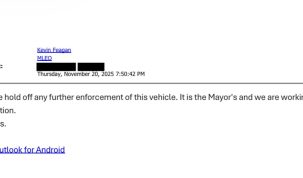Port Hope resident Andrew McMartin spoke to council Tuesday night, advocating for additional residential units (ARUs) in rural areas on private and shared lanes.
Along with his wife Vanessa, who didn’t speak, McMartin is seeking a bylaw review and amendment aligning with Ontario’s housing goals and Port Hope’s ‘Housing for All’ initiatives.
The goal, he said, is to ensure fair, equitable access to ARU opportunities for rural residents.
His property includes a serviced outbuilding that qualifies as an ARU, though they were initially unaware of private and shared lane restrictions. Following some renovations, they used the building for family and friends visits and also gained some supplemental income until a complaint was made by a neighbour and the zoning restriction was discovered.
McMartin said he began working with Port Hope council and staff and one problem identified is that current bylaws are inconsistent with provincial, county and municipal housing priorities.
He noted that bed and breakfasts, agri-tourism and AirBnBs in primary residences are permitted, but small ARUs for family, friends or income are not, adding there are no safety concerns with access to their residents or outbuilding by emergency services.
“The urgent need for more housing is well-established – provincial, county and municipal priorities all identify it as a crisis and call for action,” McMartin said. “ARUs offer a low-impact solution and are already prioritized by Ontario’s government yet many rural residents remain excluded due to limiting blanket style zoning restrictions that can’t consider specific solutions for specific problems.
“At the same time, tax rates continue to rise sharply and the municipality has an opportunity to help residents meet these financial pressures by enabling modest income-generating uses of their properties.”
McMartin said two of three households on his lane have applied for ARUs.
“This is not unique, obviously. There are many other private lanes across the municipality, with many more likely uncounted,” he said. “I think in the end, these limitations are also compounded by the municipality’s approach to the sale of roads to private individuals, transactions that seem to leave neighbouring residents subject to access restrictions, diminished property rights and unequal treatment.”
McMartin added “if we are serious about housing for all, it seems to me that the time might be now to stop focusing on why we can’t and begin addressing how we can. We’re asking that council specifically consider expanding the scope of the zoning review related to ARUs proposed in the last council meeting.
We would like to see this become a more comprehensive review of ARUs across the entire municipality, including process considerations to increase specificity in application requirements for ARUs that could replace blanket-style prohibitions.”
Councillor Les Andrews asked if McMartin was informed of the private lane restrictions when he applied for a permit for the renovations. McMartin said he didn’t have time to tell that story within the 10 minutes allotted for the presentation, but summed it up as a miscommunication with the building office.
Councillor Claire Holloway Wadhwani didn’t believe it was the time for too much debate or advice from staff, recalling a motion passed just over two years ago for a similar zoning prohibition issue.
“We passed a motion on the fly after a lot of exchange between council and staff and I’m just conscious that that didn’t really work out well – it ended up taking two years to come to resolution and I think there was some confusion about what the council resolution ended up saying,” she said. “I am interested in looking at this and having staff take a closer look and provide some more advice to council on whether the provision could be removed or whether instead of a blanket prohibition it could be more specific so we could be clear about what the risks or concerns are, but I would like to reserve that consideration to September to allow us all to do a little more research and consult with staff.”
Holloway Wadhwani also noted that the report reviewed by council in July that was referred to in McMartin’s delegation came with recommendations based on the council motion from two years ago.
“As I’ve been reflecting on that staff report, I’ve also had the thought that it was based on what we knew two years about the barriers to ARUs and infill housing and there are clearly other barriers that we were not aware of, that we didn’t cover in that resolution so I think it might behoove us to take stalk of that and see if there are provisions like this one and maybe some others that we want to add to the list of issues that staff are going to review and come back to council with concrete recommendations on how we can remove barriers ARU development in both the rural and urban parts of our community.”
Councillor Todd Attridge said he agreed with the comments from Holloway Wadhwani.
“I think what’s being raised here, although obviously is very personal to the McMartins and specific to their property, it does shed a light on the fact that there might be something a bit more systemic that council needs to look at it and I think this is a conversation for later with the help of staff to figure out what is our intention around ARUs,” Attridge said. “What position do we want to take on the use of some of these shared lanes, it’s a bigger conversation that I think we have to delve into.”
Deputy Mayor Vicki Mink, chairing the virtual meeting in the absence of Mayor Olena Hankivsky, said she’s a rural resident and it’s good for the municipality to have goals to increase housing and start thinking creatively and promoting things like ARUs that residents can have on their property.
“I agree with what Councillor Claire said about opening up the discussions that come forward regarding ARUs and how can we make it more possible, more accessible to the people in our community to have these opportunities at their homes,” Mink said.
Desta McAdam, who is Port Hope’s director of development services, said she agreed with McMartin’s assessment that the municipality needs more information on the prevalence and locations of all private lanes.
“Unfortunately we don’t have that data set right now and I do think it’s important in terms of even taking the next steps to reviewing and considering changes to existing regulations to really understand the existing context that we’re working within across both the urban and rural area as it relates to private lanes or private roads,” she said.
“Staff are working to prepare a report to address Mr. McMartin’s delegation that you received today and really what we’re looking at is how Mr. McMartin’s request could be addressed while considering the existing work plan that staff have established for the remainder of the year and looking forward and into next.”
McAdam said the hope is for the report to be on the agenda for the September regular council meeting.
Mink asked McAdam about the risk of not having an inventory of private roads in the event of emergency services needing access.
McAdam said there will be conversations with other directors to help compile the information, including with Director of Protective Services Jason Williams.
“I hesitate to speak on the risk just as it’s really not for me to say right now and I would be looking to Director Williams to assist me with providing that response in that following report in September,” she said.





















